

2016-07-28 12:00:00 AM | 12614 ![]() Print
Print ![]() PDF
PDF
Let’s be honest, you probably clicked on this blog post because you find both the image and the headline over-sensationalized. Now that's a classic clickbait – a clever title that intrigues you just enough to get you to click (it's not a behavioral dysfunction, it has something to do with our brain, the way we quickly perceive and want to analyze things).
According to Peter Koechley, the Co-Founder of Upworthy.com, “The difference between a good headline and a bad headline can be just massive. It’s not a rounding error. When we test headlines we see 20% difference, 50% difference, 500% difference. A really excellent headline can make something go viral.”.
Let the truth be told. A lot of us do go overboard when there’s a new ‘trick’ for pulling in traffic/visit to one's site. Now the sick sense to this is that click-baiting is no new fling! apparently, it's both a psychological and behavioral phenomenon...yep!
Warning! This content is Rated PG +.
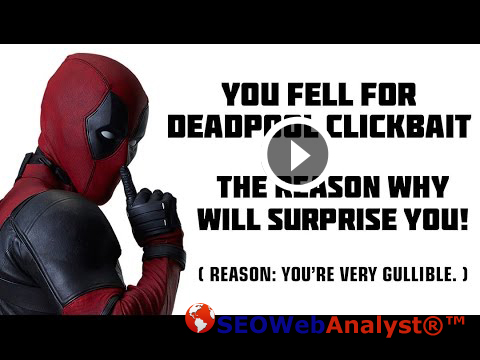
"DON'T BE FOOLED THIS AIN'T A VIDEO, I BET YOU TRIED TO CLICK ON IT?!".
Well if you’re new to THE “click-bait” GAME (which I hardly doubt), we at the dark Vader's doom star station define it as a content marketing tactic used by some overlord websites and blogs—[such as Huffington Post, Upworthy, and BuzzFeed with some popular Facebook apps like Meaww, Nametests(just to name a few)]—to convince online audiences to visit their website. With the intentions of vague titles and adjectives that deliver “curious” or “perplexing” content, it’s easy to draw readers in (Which is the main purpose of click-baiting- draw in a huge amount of loose traffic).
Clickbait can also be define as a pejorative term describing web content that is aimed at generating online advertising revenue, especially at the expense of quality or accuracy, relying on sensationalist headlines or eye-catching thumbnail pictures to attract click-throughs and to encourage forwarding of the material over online social networks. Clickbait headlines typically aim to exploit the "curiosity gap", providing just enough information to make the reader curious, but not enough to satisfy their curiosity without clicking through to the linked content...source wikipedia.
While many of us agree that clickbait is annoying, misleading, and often suspicious, it’s usually incredibly effective (no doubt). But what gives these types of headlines so much power?

What is the secret power behind clickbait that gets people clicking? A lot of the mystery can be traced back to behavioral science. When you see a clickbait headline, you’re aware that you’re being baited but often click anyway (oh well!). Emotions are largely to blame: studies have shown that emotional responses play a big role in determining what we click on. Anger and sadness are especially compelling forces while humor, inspiration, and surprise work almost as well...(for real)!.
Curiosity is another driving factor (which always kills this cat). The “information gap” theory says that the difference between what people know and what they’d like to know produces uncomfortable feelings of deprivation – in other words, curiosity. It’s easy to provoke people’s curiosity by introducing them to a little bit of information about something, but not too much (catch the drift?). That’s why you’ll see plenty of “you’ll never guess what happened next” headlines on Upworthy and other sites, teasing readers to click and satisfy their urge to know more (they should stop patronizing us!).
Yet another way clickbait uses psychology to get page views is through its heavy reliance on lists. List headlines are especially tempting to readers and there are a few different reasons why. First, numbers tend to stand out when you’re skimming through endless headlines – odd numbers in particular. Numbers and lists also help organize information and people are naturally drawn to material that’s easier on the brain. Finally, list headlines give a reasonable idea of an article’s length, so readers know how much time and attention they’ll need to devote to a story.
If you ask me most click baits are totally misleading! why? because you don't have to have a heart not to feel that pinch at the back of your head that says "What!"...after clicking on an image like the bodacious one below, only to get on a post that is simply short of words or none, coupled with a lot of Google AdSense placements here and there. The worst part is that you might try to navigate through the hell you find yourself on, only to create more mess (ok maybe the content is on the next page- hiding if you scroll down- you clicked a link) with pop up window tab ads that open in new tabs and on new windows.
Some of these clickbait images her mostly provocative (having bare female pictures etc) and the most intuitive idea was to add a play icon that will make it seem like the content is a video.
HAVE YOU WATCHED THIS MOVIE?!
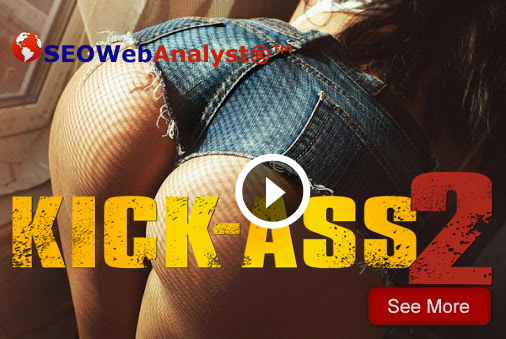
"OK OK! IF YOU ARE STILL CLICKING ON IMAGES LIKE THIS: PLEASE READ ON".
If there is any post that explains this scenario it will be seoprocessor.com post on why clickbait headline is bad for your website, but I totally concur with their "Problem #3: Clickbait Headlines Get Visitors, Not Customers".
In fact the reports on clickbait were so bad that in 2014, the ubiquity of clickbait on the web had begun to lead to a backlash against its use. Satirical newspaper The Onion launched a new website, ClickHole, that parodied clickbait websites such as Upworthy and BuzzFeed, and in August 2014, Facebook announced that it was taking technical measures to reduce the impact of clickbait on its social network, using, among other cues, the time spent by the user on visiting the linked page as a way of distinguishing clickbait from other types of content...source wikipedia.
But even with all these facts, I for one do believe that clickbait headlines can actually do more than send you loose traffic, it is very possible to convert this spike flow in traffic into customers. How to do this is to simply stop the miss-match of your headlines and images, stop using misleading headlines simply to incentive click-through.
A good example will be this clickbait advert placed on Facebook back in 2014 with the headline "How am I earning Online?" with an image of a bare female posed to increase click-through...am sure the advertiser generally wasted money on this campaign....he was betting on getting the traffic to the site and then convert them...But the first error here was targeting the wrong audience, most people will click on the image before they will read the headline and most of them will be interested in seeing bare pictures of ladies instead (wrong mindset to promote a make money online scheme).
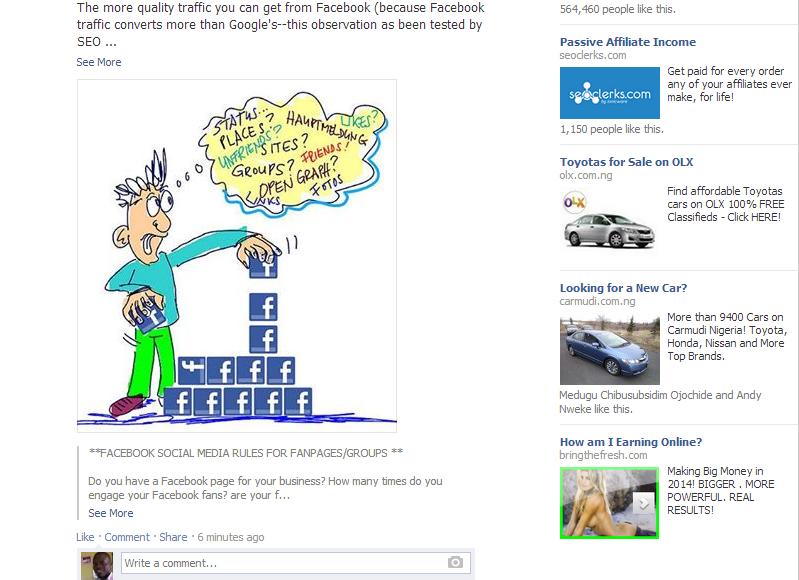
another fact is that click-baiting is still on social media sites (especially Facebook)...with most from young bloggers that don't understand the right techniques to deploy and are all keen on getting viewership for their Google AdSense revenue.
In this section of my post, I will be sharing with you some constructive ideas which I believe can be very useful when writing a blog post title...which has a very potent SEO value too. Your Blog title is very important, especially when trying to get search traffic from search engines like Google. So using the same strategy pointed out in this post can aid you to see the grim light of a better click-through rate on your SERP standing and a higher click-through rate; a better website performance will surely come in handy to kick off that competitor sitting on your #1 search engine ranking position.
1.) First you need to target a keyword.
Targeting the right keyword does not mean you must always write about a trending topic, because come to think of it not everyone is talking about your latest post on the internet. And there are lots of other info-medias out there that will make it very daunting for you to even get the kind of attention your post deserves.
So yes you need to do some sort of research on the blog post, and the first hurdle to jump will be your keywords...use keyword suggestion tools like semrush.com or serpstats.com, or better yet utilize Google keyword planner (read on how to utilize it via Pay Per Click (PPC) Advertising).
This will aid you to target relevant and prospective keywords that are not too competitive and still tangible in terms of traffic, it's better to target keywords you can easily gain SEO traction from than aiming high for keywords that are far beyond your reach.
2.) Keyword Headline Titles.
Next is to get a title that will do the trick, a title that will be a call to action and at the same time be sensational. There are tools out there you can utilize to help you create such constructive clickbait headlines. I personally like PORTENT’S TITLE MAKER, their tool is kind of groovy. Well, their tool allows you to simply input your target keyword phrase and then generate beautifully crafted headlines. Another tool you can utilize under the same category will be TWEAKYOURBIZ TITLE GENERATOR, quite a nifty tool with more options for you to easily generate adjectival headlines.
Oops! almost forgot to include HUBSPOT’S BLOG TOPIC GENERATOR. they offer 3 option forms, for you to input your keyword phrases in each form (more like a keyword mix), this will help you to shuffle out predefined headline titles you can easily adapt or fine-tune.
3.) Title Headline Analysis.
After you must have gotten the list of headlines you are convinced will work; that has been generated from the steps above, the next call to action will be for you to analyze your title headlines.
There are two headline analyzers I will recommend for such analysis; these are COSCHEDULE and EMOTIONAL MARKETING VALUE HEADLINE ANALYZER FROM ADVANCED MARKETING INSTITUTE.
Coschedule provides more insight and analysis with a recorded score of each of your previous headline tests, a sentimental score, a word balance score, and a title length score with a Google preview of the headline title and email subject lines. All this is to help you analyze how your title will look and feel in front of your targeted audience with a headline analysis score that will guide you with your choice of headlines.
Whereas with Emotional Marketing Value headlines are shown with predominant emotion classification. As you know, reaching your customers in a deep and emotional way is a key to successful copywriting, and your headline is unquestionably the most important piece of copy you use to reach prospects.
Your headline will be analyzed and scored based on the total number of EMV words it has in relation to the total number of words it contains. This will determine the EMV score of your headline.
In addition to the EMV score, You will find out which emotion inside your customer's headline most impacts;
Intellectual: Words that are especially effective when offering products and services that require reasoning or careful evaluation.
Empathetic: Words that resonate in with Empathetic impact often bring out profound and strong positive emotional reactions in people.
Spiritual: Words that have the strongest potential for influence and often appeal to people at a very deep emotional level.
4.) Headline Social Trends and Popularity.
You know it is one thing to sit down and write a constructive and informative post, and it's another thing to get your post on a wildfire sensation targeting the right audience. The most preferred tool is Buzzsumo, it's a tool you can utilize to show you the number of shares an article has gotten across several social media platforms.
In short, the headlines are already validated socially. You can use the social shares as signals that indicate whether the audience liked the headline or not. The tool has other features you can utilize to dig further, a trial account will be wise to start with, for you to see what it can offer you.
5.) Deliver what your headline promises.
Clickbait headlines are powerful and there is no reason you can’t use some of the psychology they use to get clicks to improve the traffic traction of your own website. But I’m not saying you should start rewriting your headlines to sound more like Buzzfeed. The goals of clickbait sites tend to focus on traffic, without taking engagement into account.
Conversely, most online marketers will do better with a more effective approach that focuses on building trust and authority with valuable content. The best headlines don’t just get clicks, they get the right kind of clicks that deliver both visitors and customers.
6.) Call To Action Images.
You should also consider adding images to your content, most images should be in tune with your headline title. They should also project what your audience will like to read unlike the image of the Facebook Ad "Make Money Online" above, you can utilize images that are footnotes to your headlines or can be irony or a metaphor to your content headline.
Lastly, most clickbait links that are images do come with a play icon, the reason for this is to simply ease the decision for your targeted audience to click (since videos on Facebook do have a higher click-through rate).
One thing I did like to suggest is for users to try and mix memes as well as part of clickbait headlines, this can be a nice experiment. Currently, I will be conducting an analysis on the power of click baits and how it can be used thoroughly to increase click-through and traffic to well-constructed content.
7.) Timely Posting and Scheduling.
You need to schedule your post effectively and timely to target the right audience, this will be positive as your post will get more engagement when your audience is much online than vice versa. On Facebook, you can achieve this by visiting your Facebook Fanpage and clicking on the insight tab. Next, you click on a post on the navigation bar on the left, and whoola! you have all the data to predict the best time to post on your Facebook Fanpage.
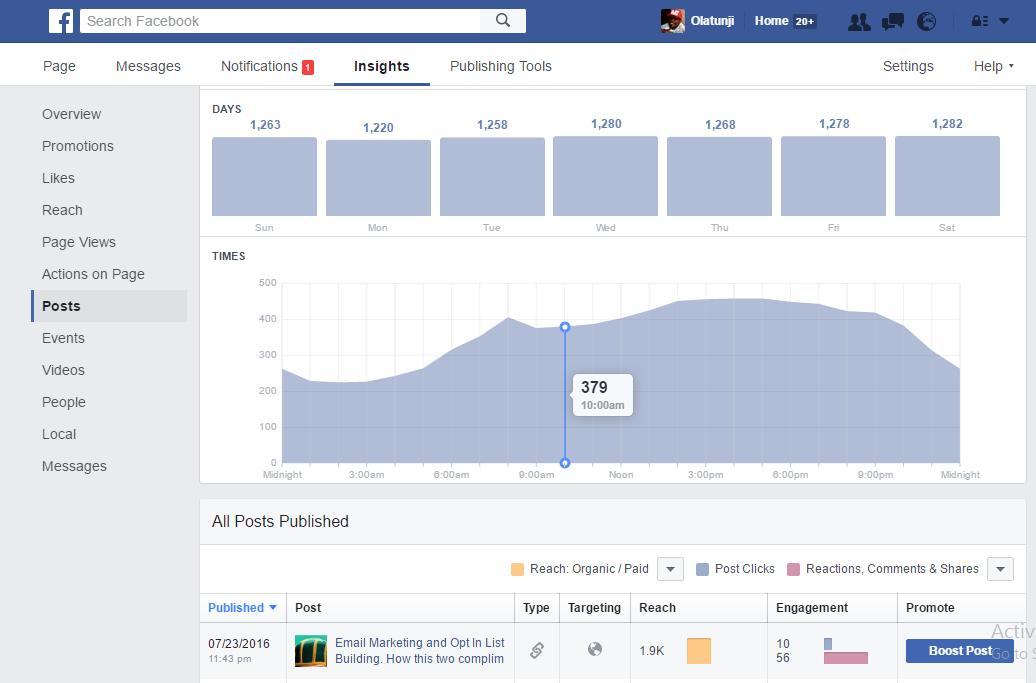
As for Twitter, it is a bit more demographic than checking out timely manner to engage your audience. If you visit https://analytics.twitter.com simply login to your account prior to visiting the URL (better idea) click on the audience navigation at the top and then click on your demographic, to get a wilder perception, it will be best to compare your results with your Twitter followers, as the analytic result is simply providing you organic reach of your tweets.
The best top countries should be the ones you should time your tweet around since timing zone can really be a backslide effect in reaching more of your audience, so note the top countries and tweet your post during the hourly time suggested by Facebook eg Facebook suggested 4 pm to 6 pm you have more audience(no need to calculate time zone difference), hence on Twitter, you have a lot of Indians engaging with your tweets (or sees your tweets). Best you tweet during the hours when your Twitter audience is best online (taking note of time differences, you might want to schedule your post using some automated social management software).
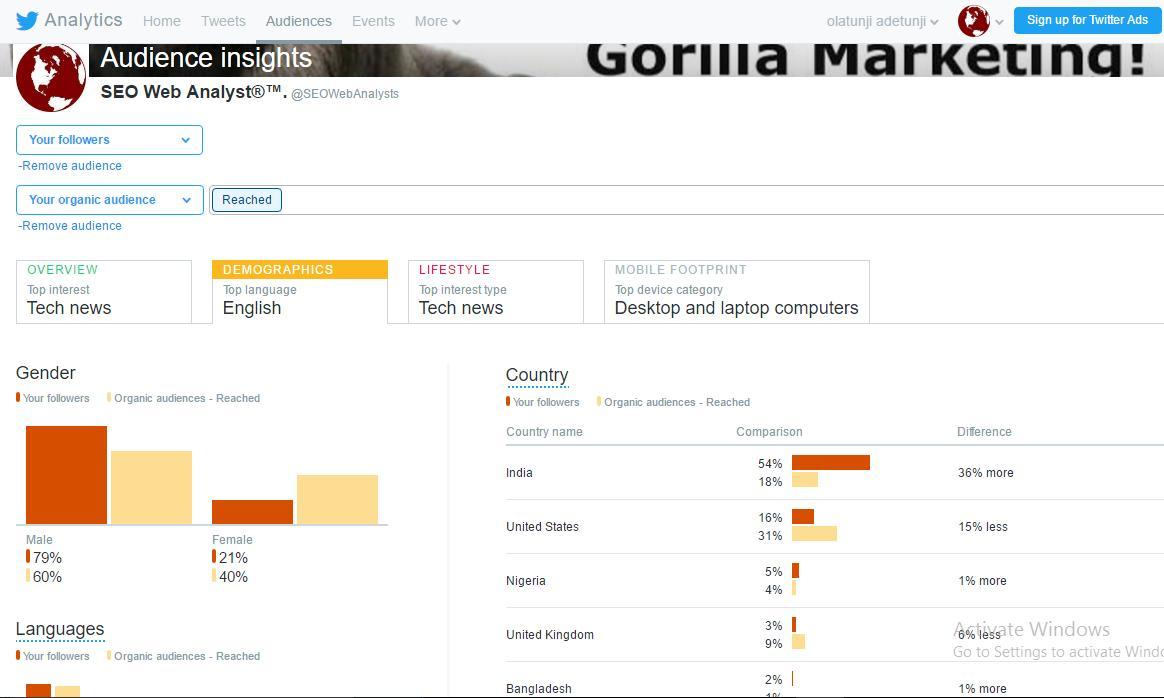
Conclusion:
If you can execute these steps (as I will be deploying them as well), you will notice a steady increase in your traffic, and a steady increase of traffic means more impression views/clicks on your Google Adsense ads. Another benefit to clickbait is that it can become a successful viral content campaign, if you can spend a bit on it, increase your reach and engagement.

I am a seo web analyst and have a love for anything online marketing. Have been able to perform researches using the built up internet marketing tool; seo web analyst as a case study and will be using the web marketing tool (platform).
How To Fix Cloudflare Error 522 Connection Timed Out
How To Optimize Cache Performance via HTACCESS Apache Server
How To Fix GA4 Showing Wrong Domain Traffic
How To Reactivate Google Adsense Account
How Do You Write Pitch Deck That Wins Investors
Effective Lead Magnet Funnel Examples For Businesses
How To Promote FMCG Products Using Digital Marketing
The Main Objectives Of SEO in Digital Marketing
How Artificial Intelligence Is Transforming Digital Marketing
Google CEO Sundar Pichai: Search will profoundly change in 2025